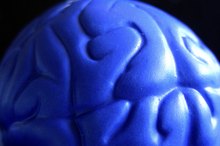Frontoparietal Stroke
Stroke affects approximately 700,000 Americans annually, according to the University Hospital website. A stroke is an abrupt deprivation of the blood flow to the brain due to a blockage or the rupture of a blood vessel in the brain. This causes a lack of oxygen and nutrients to the affected area of the brain, affecting the functions that the area controls, such as walking. A frontoparietal stroke affects the frontal and parietal lobes of the brain.
Effects of a Frontoparietal Stroke
The brain consists of three primary regions: the cerebrum, cerebellum and the brain stem. The cerebrum is the largest and most developmentally advanced portion of the brain. It has a right and left hemisphere. The frontal lobe controls problem solving, selective attention behavior and emotions. Damage to the frontal lobe will affect these functions. The right and left parietal lobes control sensations of touch and pressure.
- The brain consists of three primary regions: the cerebrum, cerebellum and the brain stem.
- The right and left parietal lobes control sensations of touch and pressure.
Signs and Symptoms
Causes of Temporary Leg Paralysis
Learn More
The signs and symptoms of a stroke depend on the area of the brain affected. Symptoms may include:
- headache
- numbness with weakness or paralysis on the affected side
- confusion
- sudden unconsciousness
- vision impairment
- dizziness
- lack of coordination
Strokes in the right hemisphere of the cerebrum may affect the left side of the body, while a stroke in the left hemisphere may affect the right side of the body. Damage to the right parietal lobe affects vision, touch, sound and taste. Damages to the left lobe disrupt understanding of the spoken and/or written language.
- The signs and symptoms of a stroke depend on the area of the brain affected.
- Damages to the left lobe disrupt understanding of the spoken and/or written language.
Treatment
Treatment includes an initial evaluation and assessment to determine if the cause of the stroke is a blockage or bleeding. The patient is stabilized and necessary supportive measures established to overcome acute problems, such as difficulty breathing, hypertension and dehydration. Then steps are taken to prevent and treat complications. This is followed by rehabilitation to return the patient to optimum recovery. Lifestyle changing techniques are provided to prevent subsequent strokes.
- Treatment includes an initial evaluation and assessment to determine if the cause of the stroke is a blockage or bleeding.
- The patient is stabilized and necessary supportive measures established to overcome acute problems, such as difficulty breathing, hypertension and dehydration.
Research
Signs of a Stroke While Sleeping
Learn More
The warning signs of an ischemic stroke may be apparent as early as seven days prior to the event 2. According to a study by Dr. Peter M. Rothwell, published in the scientific journal of the American Academy of Neurology in March 2005, 2,416 individuals who had an ischemic stroke were examined. In 549 of these patients, TIAs--transient ischemic attack or mini strokes--were experienced prior to the ischemic stroke, with most occurring within seven days. This report supports how critical the timing and early treatment of a TIA is in preventing a major ischemic stroke.
- The warning signs of an ischemic stroke may be apparent as early as seven days prior to the event 2.
- In 549 of these patients, TIAs--transient ischemic attack or mini strokes--were experienced prior to the ischemic stroke, with most occurring within seven days.
Related Articles
References
- "Annals of Neurology"; Increased frontoparietal integration after stroke and cognitive recovery; Sharp DJ, et al.; November 2010
- Science Daily; Stroke Warning Signs Often Occur Hours or Days Before Attack; March 15, 2005
- Merck Manuals: Stroke
- Frontotemporal Disorders: Hope Through Research. National Institutes of Health. National Institutes of Neurological Disorders and Stroke. August 2019
- Pula JH, Yuen CA. Eyes and stroke: the visual aspects of cerebrovascular disease. Stroke Vasc Neurol. 2017;2(4):210–220. Published 2017 Jul 6. doi:10.1136/svn-2017-000079
- McInnes K, Friesen C, Boe S, Specific Brain Lesions Impair Explicit Motor Imagery Ability: A Systematic Review of the Evidence, Arch Phys Med Rehabil. 2016 Mar;97(3):478-489. doi:10.1016/j.apmr.2015.07.012
Writer Bio
Norma Chew is a retired registered nurse who has been a freelance writer since 1978. Chew's articles have appeared in the "Journal of the Association of Operating Room Nurses" (AORN), "Point of View Magazine" and "Today's OR Nurse." Chew has a master's degree in health care administration from Nova Southeastern University.









